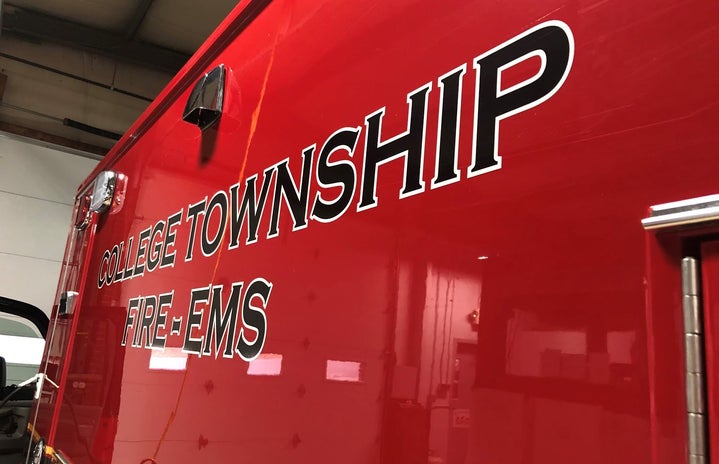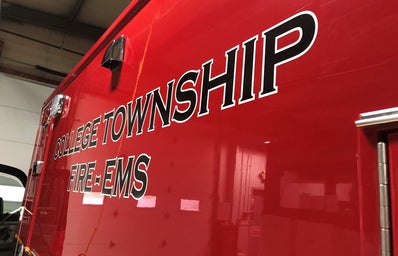On the corner of our own East Brooklyn Street sits a red brick building, low to the ground. The outside of the building is tranquil, undisturbed, almost sleepy. The façade is misleading—inside the building sit several massive engines: a rescue engine, fire engine, two ambulances, and a grass truck. Kenyon students and fire department employees dressed in navy uniforms work to the hum of pagers. The atmosphere of the station is always a little tense; they are on duty, waiting for the next 911 call.
Historically, the College Township Fire Department has kept the students and residents of Kenyon and Gambier safe during medical emergencies and residential fires. Although students are “volunteers”, their commitments are extremely demanding—which makes sense, because every decision made as a firefighter or EMT is a question of life or death.
To earn the EMT Basic Certification, students will finish over 150 hours of coursework in night classes over the academic year. Students also attend weekly trainings for learning techniques critical to managing both medical and fire emergencies. They typically stay over the summer to complete another 160 hours of coursework to become Firefighter I certified (students must be both a firefighter and EMT). And to receive EMT Advanced Certification, it’s another 200 hours of training. In between training, students work at the fire department on 911 runs. To put things into perspective—every time that someone in the Kenyon or Gambier community calls 911 for a medical or fire-related emergency, it’s our students and employees who run out to help. Yes—from every accidental fire alarm pulled to every elderly person having a stroke, our fellow Kenyon firefighter/EMT’s are sprinting out.
Our students at the College Township Fire Department have the same exams and workloads as the rest of us. Yet they also have the safety of everyone else on their plates, too. It’s really incredible work and dedication with which they consistently support our community. So in honor of them, here is a three-part series about our senior student firefighters.
Today, we will be interviewing Edwin Ramirez ‘20. Edwin is a biochemistry senior. He is a first-generation college student whose family immigrated from Ecuador. His Latinx heritage is a part of him that he really cherishes. He has been in the department since his freshman year and currently leads the student corp on the College Township Fire Department with Jo Stanley ‘20 and Ryan Nader ‘21. Edwin’s most important values are dependability, honesty, and commitment. They are also the values that he believes are most important to being an excellent Firefighter/EMT. Although he is very busy as a firefighter/EMT, he likes to do other things too. In his free time, he likes to nap, work out, and procrastinate with friends.
Yixuan: I know being a member of CTFD is huge commitment—what compelled you to join and to stick with it in the first place?
Edwin: I came into Kenyon as pre-med. So when I came as a prospective student, I stayed with someone who was on the fire department. He told me a lot about the experiences that he’d had and the experiences that he looked forward to having. I thought that being on the fire department was a really cool way of getting hands-on medical experience without really being a doctor. So I thought it was going to give me a first glance of what I should expect going to medical school. And I stuck with it because I still am pre-med—or I’m pre-heath, as for the moment.
Y: What are some things you guys do in training to prepare for real-life disasters or scenarios?
E: Uhh… we do a lot. It’s not just training for scenarios that involve cardiac patients, or respiratory patients. We do a lot of issues of what would happen in these niche scenarios—because you never know what could happen in a call, right? One thing that I can think of is called a “Hose Maze,” that’s just [being] accustomed to being in your gear, and knowing how to rely on other senses besides sight and hearing. We have to really know technique and what’s around you, and know and trust what you’re following or holding onto will lead you to where you want to go. Other training scenarios involve going around campus and going over specific examples: what if this patient was down in this really small closet, or in like this really small corner of a bathroom? We really practice for the really hard scenarios, so if and when they do arise, we’ll be ready.
Y: How has your training and work as a firefighter/EMT affected your perspective on life, both as a person and a Kenyon student? How have you changed since becoming a firefighter/EMT or what has the job taught you?
E: I think it’s changed me a decent amount. [He laughs.] I came to Kenyon all bright-eyed and bushy-tailed. I think I knew exactly what I wanted to do in life, but I didn’t know what characteristics I needed—or what life attributes or lessons I needed to be that. So I wanted to be a doctor—you can just take the classes and be a doctor, but what other life skills do you gain? Since being in the department, I’ve matured a lot… [he laughs] I plan for the “what-if” scenarios. Every time I go into a new room, and I’m on duty, I plan my quickest and safest escape route. In Gund Commons, when I’m duty, and there’s a table right there, I try to move it so there’s a clear cut path to the exit. I think that just shows preparedness and readiness for any scenario. Being on the fire department, you need to show initiative and want to be better. I think I’ve shown that not only at the fire department but also in my classes. I know that doing some sort of extra credit assignment or extra reading won’t really affect the overall outcome of the class, but if it’s something that I really want to get better at, then I show initiative to put in the work to get better. I feel like the fire department teaches you a lot of lessons: if you can be the best here, then we teach that you can be the best anywhere.
Y: Lastly, you guys do so much for the community. What can we, as students, faculty, and everyone in between, do for you guys?
E: I don’t think that there’s a lot that you can do for us. I don’t know. I think you do this job and realize that you’re not owed anything. You do this because you want to, you do this because there’s a bigger purpose to this. You don’t do this for the thank you’s or the money… because let me tell you right now—a volunteer does not make very much. But I think… I don’t know. I think there’s this understanding that a lot goes into the fire department, but also an understanding that we’re all well-qualified and very well trained to handle any and all scenarios. We’re not a “student organization,” we’re not a “club”—we’re a job. And it takes a lot to do this job. And I think we have some really damn good students. It says a lot about someone who can come in their freshman year and stick with it for four years because it’s very demanding, but it’s definitely been the best four years of my life.
Thanks for reading! Stay tuned for parts 2 and 3 of the CTFD Student Firefighter/EMT series!
Image Credit: Author


